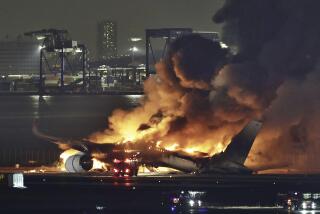FAA Seeks More Crash-Resistant Airline Seats
- Share via
Making airline seats more crash-resistant has been proposed by the Federal Aviation Administration.
Improved safety standards for seats in new aircraft were set by the FAA on June 16. The same new seat standards would apply to existing planes (certified after 1958) that are owned by large carriers and commuter airlines. These airlines, under the FAA plan, would have a seven-year grace period to retrofit their planes. The final date for completing this process, if a proposal is approved, will be June 16, 1995.
Public comments on the retrofitting proposal can be sent to the FAA.
New seats will be required to be stronger and more resilient, thus absorbing more of the impact of a crash landing. Aisles will be less clogged, thus allowing better emergency evacuation of planes. Smoke, fire and the release of toxic gases are hazards beyond the impact of a crash. Thus, getting out of planes in the shortest amount of time is crucial.
Key Survival Factor
Statistics indicate that in crashes in which passengers have survived, seats and other cabin furnishings have contributed to injuries, and have trapped and incapacitated passengers and crew members.
Failures range from seat collapses to the breakaway of the seat assembly from the floor. Entire cabin floors can be deformed in survivable crashes and the ability of some seats to stay in place and restrain passengers is a key factor in possible survival.
A survivable accident is generally considered one in which the impact is not of such intensity as to be fatal to all passengers.
Seats now are built to FAA requirements set in the 1950s when speeds were less than those used by today’s jets, and the FAA has long been criticized by many for not doing more to improve seat safety standards. The new proposal was in response to a Congressional request.
Seats today are supposed to withstand 9 Gs (nine times the force of gravity) in forward deceleration, 2 Gs upward, 1.5 Gs sideward and 4.5 Gs downward. According to the independent National Transportation Safety Assn., human bodies can withstand deceleration forces of up to 27 Gs without irreversible injury when restrained only by a lap belt in a survivable accident.
Another study has indicated that a properly restrained human body can withstand an impact of up to 40 Gs for a brief time.
The NTSA also pointed out that seats in cars sold in the United States are required to be capable of resisting 20 Gs of forward deceleration.
New Seat Standards
Under the FAA’s new seat standards the forward deceleration factor would stay at 9 Gs, with the upward ratio raised to 3 Gs, sideward to 4 Gs and downward to 6 Gs. “The new standards are based on tests, including dynamic as well as static elements, while the current standard is based on just a static pull test,” an FAA spokesman said.
The new standards also call for seats to remain attached at all points of attachment, though the structure may yield.
Using seats that face the rear of the plane has been recommended by some observers as a superior method to improve passenger safety. Some military aircraft have such rear-facing seats, which are said to offer maximum distribution of force over a passenger’s torso when rapid deceleration happens, instead of focusing force on one part of a body, often the head, in seats facing forward.
While agreeing that rear-facing seats might be designed to provide greater support for the upper torso, the FAA said there is no available data to demonstrate that such seats, considering their increased weight, would be cost-effective.
In effect, the proposed amendment doesn’t require the use of aft-facing seats, but does permit their use. However, it seems unlikely that commercial airlines will introduce such rear-facing seats.
Lap Vs. Upper Torso Belts
The new standards for seat performance are still based on lap belt restraints, but the rule doesn’t prohibit the installation of upper torso restraints. The FAA said that upper torso restraints could create design problems associated with a stronger seat back and floor structure. Moreover, shoulder straps could create entanglement problems for passengers trying to evacuate planes quickly.
Unfortunately, there is a cost factor that enters into airline safety matters. Putting in new seats means more cost for the carriers. Each pound of weight increase can result in 15 gallons of additional fuel a year, according to the FAA. The FAA estimated that the weight increase, based on responses from seat manufacturers, ranges from 0.3 pounds to 1.5 pounds per seat.
However, the NTSA said that many new seats already developed by manufacturers that meet the new standards are lighter than existing seats and would pay for themselves in fuel savings within a few years.
The NTSA also is lobbying for all current aircraft to be equipped with new seats by June, 1992, pointing out that statistics indicate that 63 airline accidents will happen before the end of the FAA-proposed retrofit period.
Accordingly, the NTSA is recommending that consumers accept a $1 increase per airline ticket for two years in exchange for decreasing the amount of time that airlines get to retrofit their fleets.
All extra costs to carriers are likely, of course, to be passed on to passengers through higher fares.
Send your comments on this proposal by Oct. 14 to the Federal Aviation Administration, Office of the Chief Counsel, Docket 25611, 800 Independence Ave. S.W., Washington, D.C. 20591. Include two extra copies of your letter in the same envelope, and make sure that the letters include the full address and docket number.
More to Read
Inside the business of entertainment
The Wide Shot brings you news, analysis and insights on everything from streaming wars to production — and what it all means for the future.
You may occasionally receive promotional content from the Los Angeles Times.










